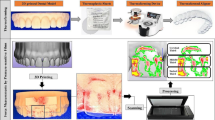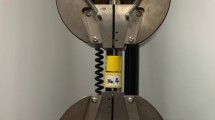Abstract
The aim of this study was to determine the influence of soft drinks on the surface of Ni-Ti archwires and their corrosion behavior. Archwires with different patterns (smooth, scratch, dimple, and crack) were selected and characterized by scanning electron microscopy and laser confocal microscopy. Immersion tests were performed in artificial saliva (pH 6.7) with a soft drink with a pH of 2.5 for 28 days. The results showed an increase in the surface defects and/or roughness of the dimple, crack and scratch patterns with the immersion times, and a decrease in corrosion resistance. A relationship between the surface pattern and the extent of the corrosion in Ni-Ti archwires with soft drinks at low pH has been demonstrated. Pattern should be taken into account in future studies, and manufacturing processes that produce surface defects (especially cracks) should be avoided.



Similar content being viewed by others
References
D.J. Wever, A.G. Veldhuizen, J. de Vries, H.J. Busscher, D.R. Uges, and J.R. van Horn, Electrochemical and Surface Characterization of a Nickel-Titanium Alloy, Biomaterials, 1998, 19(7–9), p 761–769
J. Wang, N. Li, G. Rao, E.H. Han, and W. Ke, Stress Corrosion Cracking of NiTi in Artificial Saliva, Dent. Mater., 2007, 23(2), p 133–137
H.H. Huang, Y.H. Chiu, T.H. Lee, S.C. Wu, H.W. Yang, and K.H. Su, Ion Release from NiTi Orthodontic Wires in Artificial Saliva with Various Acidities, Biomaterials, 2003, 24(20), p 3585–3592
H.H. Huang, Surface Characterizations and Corrosion Resistance of Nickel-Titanium Orthodontic Archwires in Artificial Saliva of Various Degrees of Acidity, J. Biomed. Mater. Res. A, 2005, 74(4), p 629–639
X. Li, J. Wang, E.H. Han, and W. Ke, Influence of Fluoride and Chloride on Corrosion Behavior of NiTi Orthodontic Wires, Acta Biomater., 2007, 3(5), p 807–815
H.H. Huang, Variation in Surface Topography of Different NiTi Orthodontic Archwires in Various Commercial Fluoride-Containing Environments, Dent. Mater., 2007, 23(1), p 24–33
T.H. Lee, T.K. Huang, S.Y. Lin, L.K. Chen, M.Y. Chou, and H.H. Huang, Corrosion Resistance of Different Nickel-Titanium Archwires in Acidic Fluoride-Containing Artificial Saliva, Angle Orthod., 2010, 80(3), p 547–553
Y.H. Kwon, Y.D. Cheon, H.J. Seol, J.H. Lee, and H.I. Kim, Changes on NiTi Orthodontic Wired due to Acidic Fluoride Solution, Dent. Mater. J., 2004, 23(4), p 557–565
A. Ramalingam, V. Kailasam, S. Padmanabhan, and A. Chitharanjan, The Effect of Topical Fluoride Agents on the Physical and Mechanical Properties of NiTi and Copper NiTi Archwires. An In Vivo Study, Aust. Orthod. J., 2008, 24(1), p 26–31
N. Schiff, B. Grosgogeat, M. Lissac, and F. Dalard, Influence of Fluoridated Mouthwashes on Corrosion Resistance of Orthodontics Wires, Biomaterials, 2004, 25(19), p 4535–4542
N. Schiff, M. Boinet, L. Morgon, M. Lissac, F. Dalard, and B. Grosgogeat, Galvanic Corrosion Between Orthodontic Wires and Brackets in Fluoride Mouthwashes, Eur. J. Orthod., 2006, 28(3), p 298–304
I. Watanabe and E. Watanabe, Surface Changes Induced by Fluoride Prophylactic Agents on Titanium-Based Orthodontic Wires, Am. J. Orthod. Dentofacial Orthop., 2003, 123(6), p 653–656
M.P. Walker, R.J. White, and K.S. Kula, Effect of Fluoride Prophylactic Agents on the Mechanical Properties of Nickel-Titanium-Based Orthodontic Wires, Am. J. Orthod. Dentofacial Orthop., 2005, 127(6), p 662–669
K. Yokoyama, K. Kaneko, K. Moriyama, K. Asaoka, J. Sakai, and M. Nagumo, Hydrogen Embrittlement of Ni-Ti Superelastic Alloy in Fluoride Solution, J. Biomed. Mater. Res. A, 2003, 65(2), p 182–187
N. Schiff, B. Grosgogeat, M. Lissac, and F. Dalard, Influence of Fluoride Content and pH on the Corrosion Resistance of Titanium and Its Alloys, Biomaterials, 2002, 23(9), p 1995–2002
M. Es-Souni, T. Es-Souni, and H. Fischer-Brandies, On the Properties of Two Binary NiTi Shape Memory Alloys. Effects of Surface Finish on the Corrosion Behaviour and In Vitro Biocompatibility, Biomaterials, 2002, 23(14), p 2887–2894
A. Wichelhaus, M. Geserick, R. Hibst, and F.G. Sander, The Effect of Surface Treatment and Clinical Use on Friction in NiTi Orthodontic Wires, Dent. Mater., 2005, 21(10), p 938–945
Y. Oshida, R.C. Sachdeva, and S. Miyazaki, Microanalytical Characterization and Surface Modification of TiNi Orthodontic Archwires, Biomed. Mater. Eng., 1992, 2(2), p 51–69
H.H. Huang, Variation in Corrosion Resistance of Nickel-Titanium Wires from Different Manufacturers, Angle Orthod., 2005, 75(4), p 661–665
F. Widu, D. Drescher, R. Junker, and C. Bourauel, Corrosion and Biocompatibility of Orthodontic Wires, J. Mater. Sci. Mater. Med., 1999, 10(5), p 275–281
M. Es-Souni, H. Fischer-Brandies, N. Koc, O. Bo, K. Rätzke. Chemische Zusammensetzung, Umwandlungsverhalten und mechanische Biegeeigenschaften ausgewählter kieferorthopädischer NiTi-Drahtbögen. IOK 2001, 33, p 87–106
A. Paúl, C. Abalos, A. Mendoza, E. Solano, and F.J. Gil, Relationship Between the Surface Defects and the Manufacturing Process of Orthodontic Ni-Ti Archwires, Mater. Lett., 2011, 65(23–24), p 3358–3361
I. Van Eygen, B.V. Vannet, and H. Wehrbein, Influence of a Soft Drink with Low pH on Enamel Surfaces: An In Vitro Study, Am. J. Orthod. Dentofacial Orthop., 2005, 128(3), p 372–377
J.A. von Fraunhofer and M.M. Rogers, Dissolution of Dental Enamel in Soft Drinks, Gen. Dent., 2004, 52(4), p 308–312
ISO-standard 10993-15:2000 “Biological evaluation of medical devices. Part 15: Identification and quantification of degradation products from metals and alloys”
J.D. Shenkin, K.E. Heller, J.J. Warren, and T.A. Marshall, Soft Drink Consumption and Caries Risk in Children and Adolescents, Gen. Dent., 2003, 51(1), p 30–36
L. Harnack, J. Stang, and M. Story, Soft Drink Consumption Among US Children and Adolescents: Nutritional Consequences, J. Am. Diet. Assoc., 1999, 99(4), p 436–441
C. Bourauel, T. Fries, D. Drescher, and R. Plietsch, Surface Roughness of Orthodontic Wires Via Atomic Force Microscopy, Laser Specular Reflectance, and Profilometry, Eur. J. Orthod., 1998, 20(1), p 79–92
C. Abalos, A. Paúl, A. Mendoza, E. Solano, and F.J. Gil, Influence of Topographical Features on the Fluoride Corrosion of Ni-Ti Orthodontic Archwires, J. Mater. Sci.: Mater. Med., 2011, 22(12), p 2813–2821
N.X. West, J.A. Hughes, and M. Addy, Erosion of Dentine and Enamel In Vitro by Dietary Acids: The Effect of Temperature, Acid Character, Concentration and Exposure Time, J. Oral Rehabil., 2000, 27(10), p 875–880
A.J. Rugg-Gunn and J.H. Nunn, Diet and Dental Erosion. Nutrition, Diet and Oral Health, Oxford University Press, Hong Kong, 1999, p 32
M.R. Grimsdottir and A. Hensten-Pettersen, Surface Analysis of Nickel-Titanium Archwire Used In Vivo, Dent. Mater., 1997, 13(3), p 163–167
T. Eliades, G. Eliades, A.E. Athanasiou, and T.G. Bradley, Surface Characterization of Retrieved NiTi Orthodontic Archwires, Eur. J. Orthod., 2000, 22(3), p 317–326
Acknowledgments
The authors thank Dr. Juan Luis Ribas (LSCM expert) and the Center for Technology and Innovation Research, University of Seville (CITIUS), for their collaboration in this study.
Author information
Authors and Affiliations
Corresponding author
Rights and permissions
About this article
Cite this article
Abalos, C., Paul, A., Mendoza, A. et al. Influence of Soft Drinks with Low pH on Different Ni-Ti Orthodontic Archwire Surface Patterns. J. of Materi Eng and Perform 22, 759–766 (2013). https://doi.org/10.1007/s11665-012-0311-3
Received:
Revised:
Published:
Issue Date:
DOI: https://doi.org/10.1007/s11665-012-0311-3




